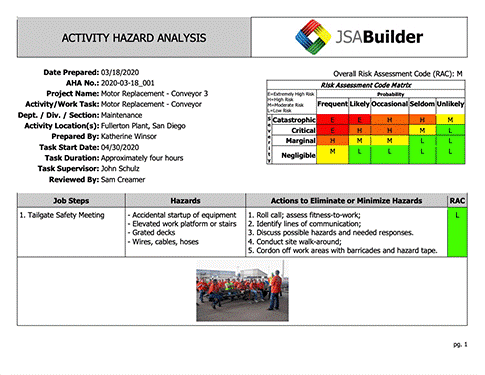Regrettably, when discussing safety at the workplace, or anywhere else, we can never say that there are no safety problems associated with our “routine” activities. Often those routine actions/conditions get ignored in safety planning, Currently we are experiencing very hot working conditions due to the weather extremes that are becoming the norm globally. Routine activities are affected by weather extremes, are ongoing, yet rarely result in any problems, most often providing a false sense of security. Regardless of where you might be located, North America, Europe, Asia, or Australia, heatwaves have affected a majority of your workers in some manner. Unfortunately, most of the time too little thought has been invested in planning for the record hot conditions associated with global climate change.

According to NASA ( https://climate.nasa.gov/evidence/ ), the earth's climate has changed throughout history. Just in the last 650,000 years there have been seven cycles of glacial advance and retreat, and with the abrupt end of the last ice age about 11,700 years ago, marked the beginning of the current climate era — and of human civilization. Most of the past climate changes are attributed to very small variations in Earth’s orbit that change the amount of solar energy our planet receives. However, the current warming trend is of particular significance because most of it is extremely likely (greater than 95% probability) to be the result of human activity since the mid-20 th century and proceeding at a rate that is unprecedented over millennia. So, it is likely that heatwaves will be a continuing to be an issue and may even become more extreme, making your hazard safety planning more important than ever. Don’t forget, that very hot conditions may also affect mechanical equipment which should therefore also be addressed in your job safety analysis planning.
According to the Occupational Safety and Health Administration (OSHA) employers should create plans to protect workers from developing heat-related illnesses. A key to protecting workers is to train them to develop an awareness of the problem. All workers should be very familiar with the signs of heat-related illnesses which can range from mild conditions such as heat rash or cramps, through to heat stroke, which can be fatal. The effects of heat stress multiply, so it's important for workers to know what the early signs look like so they can be proactive. Early signs of heat stress to look out for, may include: headache, weakness, nausea, dizziness, and irritability. We highly recommend employers and workers to utilize authoritative sources of information for training purposes, but highlights of additional signs of heat stress follow:
Heat Rash is an irritation of the skin caused by excessive sweating. The symptoms of heat rash include:
- Red cluster of pimples or small blisters
- Usually detected on neck and upper chest, groin area, under the breasts, and in elbow creases.
Heat cramps are painful cramps in muscles that can result from low salt levels and are usually caused by excessive sweating. Symptoms of heat cramps include:
- Muscle pain usually in the abdomen, arm or legs.
- Muscle spasms usually in the abdomen, arm or legs.
Heat exhaustion is the body’s response to the loss of water and salt, usually as a result of sweating. Symptoms of heat exhaustion include:
- Excessive sweating
- Weakness or fatigue
- Dizziness and/or confusion
- Clammy skin
- Muscle cramps
- Flushed complexion
Heat stroke occurs when the body no longer sweats and body temperature elevates to dangerous levels. Symptoms of heat stroke include:
- Dry, hot reddish skin and lack of sweating
- High body temperature
- Strong, rapid pulse
- Chills
- Confusion
- Slurred speech
In extreme heat conditions OSHA recommends monitoring fluid intake as the site conditions combined with intensive labor can cause rapid dehydration. In these conditions workers should hydrate (drink) with at least four 8-once cups of water per hour, but not more than six cups per hour or a total of 12 quarts per day. Care should be taken to discourage the use of fluids known to increase dehydration. Such fluids to avoid during hot working conditions include cold coffee and tea, sodas, sports drinks containing caffeine or sugar, and alcoholic beverages. OSHA recommends supplying workers with plain water or treated water enhanced with flavorings to encourage hydration.
In addition to hydration, workers in hot conditions need rest breaks to cool down, These breaks are most effective if they can occur in shaded areas that are set up with hydration sources available. It is also helpful to distribute workloads across longer schedules, amongst more workers, or possibly set work hours to start earlier in the day to reduce increases of worker’s body heat.

Hot working conditions will continue to be a major challenge for employers. To analyze and protect workers from threatening work conditions, the Job Safety Analysis (JSA) also called Job Hazard Analysis (JHA) or Activity Hazard Analysis (AHA), for simplicity referred to below as JSA, is an essential tool for guiding and promoting safe behaviors in the workplace. A quick and inexpensive way to access a simple internet-based tool to help create your own JSA/JHA is test a time-proven tool at JSABuilder.com - a great resource all employers should utilize. This tool is an easy-to-use database-driven customizable template, where the user can create custom Job Safety Analyses that are then available to be accessed by their distributed workforce. Once a JSA, is created, it resides in a secure library of JSAs/JHAs/AHAs where it and others created by the user are available for use or future modification for new or different jobs. It’s worthwhile for employers to invest the time and thought to create or modify Job Safety Analysis in JSABuilder’s simple and efficient process, but how else could you get documents addressing all the needs of your projects in such an efficient manner?
Remember, a well thought out Job Safety Analysis will focus every worker’s attention on thinking through to understand each and every activity in advance of starting a job. This tool can also help identify project/task issues that could be critical to worker safety and/or proper estimation of costs to complete the work. In extreme heat working conditions make sure your workers are reminded to remain aware of indications of heat exhaustion so they can keep themselves and their co-workers safe . When it’s time to start work, having a Job Safety Analysis is the key to conducting team job reviews to think through the potential risks that could be encountered while performing each task.
Before beginning work, the Job Safety Analysis provides a great tool to support conversations involving all competent and inexperienced workers to review potential task risks and the mitigating responses to reduce risks. These conversations help reduce complacency by focusing the work team on the current conditions at task locations which may be different than those perceived when organizing the job, or maybe they change on a daily basis. The Job Safety Analysis in supporting the identification of changed conditions can help the work team to develop and agree on mitigations at the worksite, which can be immediately documented with a management of change (MOC) annotation right on the JSA. That facilitates getting everybody to work on their tasks safely, in an efficient manner. Performing these MOC steps during reviews help to keep all team members engaged in thinking about the work tasks and help eliminate opportunities for complacency to ruin someone’s day. A JSA worksheet provides employers so much value so inexpensively, it’s difficult to understand why anyone would not use a Job Safety Analysis for every project task.
Follow us on LinkedIn and Twitter @JSABuilder, today, where our database-driven Lockout Tagout tool is currently available for a FREE 30-day trial, which will allow you to manage your lockout tagout program from start to finish. Easily enter your workers, equipment and procedures to build an entire LOTO program. Save time and money using LOTOBuilder and help your worker to work safe.
Images, links, brands discussed or displayed in this article are not endorsements or recommendations. They are for illustration of various products and types of products. JSABuilder does not recommend or express any opinion as to the applicability to any given use case or job hazards. Again, consult your safety professional to obtain authoritative opinions on applicability, selection and fitting of all the various types of PPE, then work smart and safe.